The Importance of Wayfinding Signage in the Workplace
Wayfinding signage plays a critical role in today’s workplaces, helping to maintain order, improve safety, and boost productivity. From warehouses to healthcare facilities, poor wayfinding can lead to frustration and increased stress.
Effective signage ensures employees and visitors can navigate spaces with ease, stay informed about safety protocols, and complete tasks efficiently. Successful wayfinding not only improves safety but also enhances the overall experience for everyone using the space, making the workplace more organised and productive. The following article will explore what wayfinding signage is, its importance, and how it supports both safety and operational needs.

What is Wayfinding Signage?
Wayfinding signage refers to visual cues—such as signs, symbols, and labels—designed to guide people through a physical environment. Examples include directional arrows, safety signs, and aisle markers.
The purpose of wayfinding signage is simple yet essential: to provide clear guidance so individuals can navigate spaces efficiently and safely. In workplace environments, it’s particularly important for enhancing productivity and ensuring compliance with safety standards.
Why is Wayfinding Signage Important?
- Improved Efficiency: Wayfinding signage eliminates confusion by providing clear directions to important areas such as storage rooms, meeting spaces, and emergency exits. This reduces downtime and ensures smoother operations.
- Enhanced Safety: Safety signage in the workplace communicates critical information about hazards, restricted areas, and evacuation routes. For example, Safety Signs help employees quickly identify hazards and navigate safely.
- Reduced Stress: A well-implemented wayfinding system eases stress for employees and visitors alike by providing clear navigation, which is especially valuable in large or complex facilities.
- Better Organisation: Operational signage, such as Warehouse Labels & Signs and Aisle Markers, keeps workplaces organised, making inventory management and task completion much more efficient.

How Wayfinding Signage Enhances Workplace Safety
Wayfinding signage is a cornerstone of workplace safety. Clear and visible signs ensure that employees and visitors can respond quickly in emergencies and stay informed of potential hazards. Examples include:
- Emergency Preparedness: Fire exit signs and evacuation maps ensure that everyone knows the quickest and safest way-out during emergencies.
- Hazard Identification: Warnings about spills, electrical dangers, or restricted areas are vital for preventing accidents.
- Compliance: Regulatory signage, such as safety warnings, ensures businesses meet occupational health and safety requirements.
Products like Heavy Duty PVC Labels and Non-Adhesive Tags provide durable and visible solutions for workplace safety needs.
Industry-Specific Wayfinding Needs
The design needs of each wayfinding solution are shaped by the industry requirements. From directional arrows, floor markers and aisle markers, here are some key examples:
1. Warehouse and Logistics
Why It’s Important: Wayfinding signage is crucial for directing employees to specific storage areas, loading docks, and emergency exits. It also reduces inventory errors and enhances safety in busy, fast-paced environments.
Relevant Products:
2. Manufacturing and Industrial Facilities
Why It’s Important: Signage guides employees through large, complex spaces, helps locate equipment, and ensures compliance with safety regulations. It also reduces downtime and mitigates risks.
Relevant Products:
3. Healthcare Facilities
Why It’s Important: Clear navigation is essential for staff, patients, and visitors to quickly locate departments, wards, or emergency areas. Stringent hygiene and safety standards also require effective safety signage.
Relevant Products:
4. Construction Sites
Why It’s Important: Wayfinding signage improves safety and organisation by directing workers to designated zones, identifying hazards, and supporting compliance with legal standards.
Relevant Products:

Design Principles for Effective Wayfinding Signage
To create effective wayfinding signage, follow these key design principles:
- Visibility: Use bold colours, clear fonts, and high contrast to make signs easy to read. Placement should be at eye level and unobstructed.
- Simplicity: Focus on concise messaging to reduce cognitive load and make navigation intuitive.
- Consistency: Maintain uniform design elements (colours, typography) to avoid confusion and reinforce branding.
- Placement: Install signage at critical decision points, such as intersections, entrances, and exits.
Thoughtfully designed signage improves navigation, reduces frustration, and enhances productivity by streamlining workflows.
Types of Wayfinding Signage Solutions
Certags offers a wide range of wayfinding signage solutions tailored to workplace needs:
Key Takeaways
Wayfinding signage is an indispensable part of any workplace, improving safety, productivity, and overall organisation. By implementing thoughtful, industry-specific solutions and leveraging efficient solutions, businesses can create environments where employees and visitors navigate with ease and confidence. Explore our wide range of wayfinding signage solutions to find the perfect fit for your workplace needs.
Need assistance with your wayfinding signage?
Our team is here to help you select signage solutions to enhance your workplace operations. Reach out today and let us recommend the most effective safety signs and warehouse labels for your needs.










